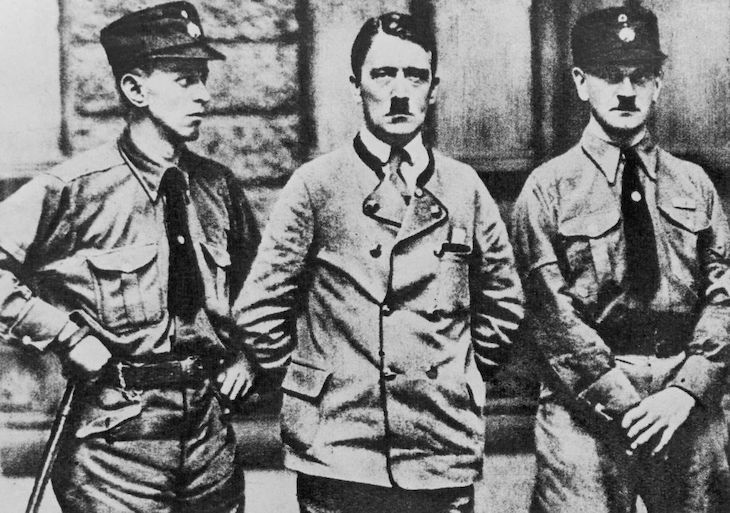The birthday party that paved the way for Hitler to win power

Ten days before Adolf Hitler died, the Führer turned 56. Just after midnight on 20 April 1945 his personal assistants gathered outside his room to offer him their congratulations. Hours later the political leadership of the Third Reich did likewise. Men responsible for mass death, including Heinrich Himmler, Hermann Göring and Albert Speer, stood inline like schoolboys to shake their Führer’s hand and wish him a happy birthday. Once they had done so, they rushed to leave Berlin.
Only the closest circle, those who would stay in the bunker until the very end remained. That night, after Hitler had gone to bed, they drank champagne and danced in the ruins of what was once the spectacular residence of the German Chancellor. Eva Braun, who would marry Hitler just hours before both committed suicide on 30 April 1945, and his secretary Traudl Junge, who would die in 2002, were among them.
It was a huge turnaround in Hitler’s personal fortunes
Early the next morning, Russian artillery shells rained down on the centre of Berlin. But Hitler was not in any danger. He was already back underground. He would never see natural daylight again.
The April 1945 celebrations of the Führer’s birthday marked the end of the personality cult that had been created around the ‘Führer’s birthday’ that had been so central to the Nazis for the previous two decades. Its starting point was Hitler’s 34th birthday in 1923. Just months after Benito Mussolini became Italian prime minister, Hitler’s propagandists in Bavaria declared him the ‘German Mussolini’ and set about strengthening the personality cult around his leadership.
On 20 April 1923, they put up bright red posters in the centre of Munich that announced that ‘our leader’ will speak at a massive gathering. The posters worked. That evening several thousand people came to hear him speak.
It was a huge turnaround in Hitler’s personal fortunes. Just years after being a loner with no real friends, Hitler, aged just 34, was publicly feted by thousands of jubilant men and women as the new ‘Bismarck’ or ‘Friedrich the Great’ – the Prussian King that Hitler idealised.
There is no doubt though that it was a moment of elation. Even his opponents, some of whom already identified him as ‘a psychopath,’ acknowledged that he had a gift for speaking.
Unlike the stereotype of Hitler constantly ranting at his audience, they noted how he delivered his message of hatred through a mixture of speaking softly before reaching crescendo, interspersing both with jokes when he would pause to listen to the laughter of his audience while he sipped his beer.
One of his opponents was Arthur Schweriner, a German Jew who went to his 1923 birthday celebration to report on what the Nazi leader was up to. He came away terrified, fearful that Munich was only days away from a violent pogrom.
Schweriner had heard Hitler promise that his movement stood upon ‘extreme ground.’ He even told his followers that: ‘We may be inhumane! But when we save Germany, we will have done the greatest deed in the world.’
It was just one of many moments in early 1923 when Hitler’s speeches contained promises of extreme violence. Just days later, the elation of his first significant birthday celebrations as Nazi leader, Hitler faced his first significant failure. On 1 May 1923, he promised his followers that they would open fire upon a socialist demonstration to celebrate worker’s day in Munich. Hitler even helped his supporters borrow weapons from sympathetic figures in the Bavarian Army. But after hours of standing around in the cold, he had to tell his men to stand down. The Army wasn’t going to let them fire. It was Hitler’s first defeat. He retreated to the Alps at Berchtesgaden, later claiming that it was at this time that he fell in love with the region.
But by the late summer, Hitler was back in action. He had remobilised himself and overcome the Mayday setback. The heroism of Albert Leo Schlageter, a German nationalist volunteer executed by the French for his role in a terrorist-like campaign of violence against the French occupation of the Ruhr district had gripped him. If men like Schlageter could continue fighting, then he must do likewise. The lesson of failure was to be more radical next time. That lesson pushed him to launch his failed putsch in November, even after it was clear that the opportunity to seize power was already gone.
Between 1923 and 1945 the same pattern would be repeated time and again. After failure he was gripped by a mixture of depression and rage. Of those two emotions, rage was always the stronger one. It pushed him back into action, providing him with both an explanation for what went wrong and a pathway for more radical measures to overcome his next obstacle.
The centenary of Hitler’s 34th birthday celebration is a reminder that the twentieth century’s greatest dictator could only respond to failure by lashing out against those he imagined responsible for it. Only time will tell if the same rule applies to the authoritarian rulers of our times.













































